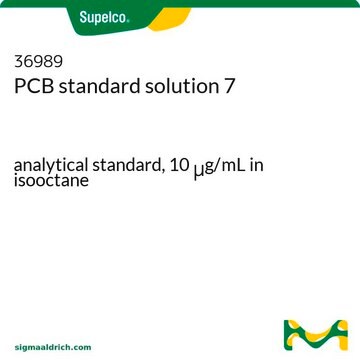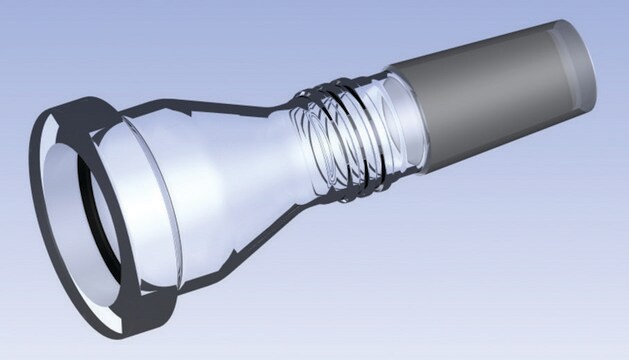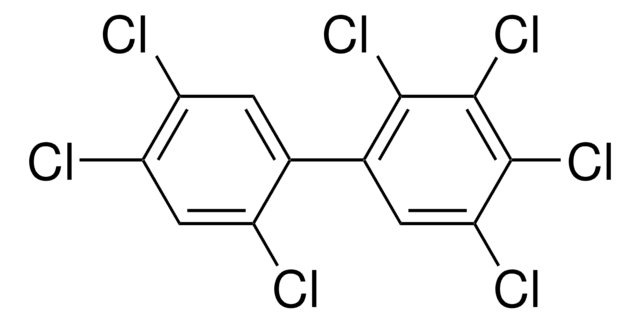BCR289
2,4′-Dichlorobiphenyl
BCR®, certified reference material
Autenticatiper visualizzare i prezzi riservati alla tua organizzazione & contrattuali
About This Item
Formula empirica (notazione di Hill):
C12H8Cl2
Numero CAS:
Peso molecolare:
223.10
Beilstein:
1946417
Numero MDL:
Codice UNSPSC:
41116107
ID PubChem:
NACRES:
NA.24
Prodotti consigliati
Grado
certified reference material
agenzia
BCR®
Produttore/marchio commerciale
JRC
Formato
neat
Temperatura di conservazione
2-8°C
Stringa SMILE
Clc1ccc(cc1)-c2ccccc2Cl
InChI
1S/C12H8Cl2/c13-10-7-5-9(6-8-10)11-3-1-2-4-12(11)14/h1-8H
UFNIBRDIUNVOMX-UHFFFAOYSA-N
Descrizione generale
2,4′-Dichlorobiphenyl is a polychlorinated biphenyl (PCB) congener whose biphenyl nucleus is substituted with two chlorine atoms. PCBs are well-known environmental contaminants and are classified as persistent organic pollutants.
Applicazioni
2,4′-Dichlorobiphenyl may be used as a certified reference material (CRM) to quantify the analyte in environmental samples by chromatography techniques.(3)(4)
Risultati analitici
For more information please see:
BCR289
BCR289
Note legali
BCR is a registered trademark of European Commission
Avvertenze
Warning
Indicazioni di pericolo
Consigli di prudenza
Classi di pericolo
Aquatic Acute 1 - Aquatic Chronic 1 - STOT RE 2
Codice della classe di stoccaggio
11 - Combustible Solids
Classe di pericolosità dell'acqua (WGK)
WGK 3
Punto d’infiammabilità (°F)
Not applicable
Punto d’infiammabilità (°C)
Not applicable
Choose from one of the most recent versions:
Certificati d'analisi (COA)
Lot/Batch Number
Sorry, we don't have COAs for this product available online at this time.
If you need assistance, please contact Servizio Clienti
Possiedi già questo prodotto?
I documenti relativi ai prodotti acquistati recentemente sono disponibili nell’Archivio dei documenti.
Robert M Burgess et al.
Environmental toxicology and chemistry, 23(11), 2534-2544 (2004-11-24)
Recent studies demonstrate that sedimentary black carbon (BC) affects the sorption of some hydrophobic organic contaminants (HOCs) to a greater extent than sedimentary organic carbon (OC). Among HOC, polycyclic aromatic hydrocarbons (PAHs) are known to interact extensively with BC. Currently
Qi Lin et al.
Ying yong sheng tai xue bao = The journal of applied ecology, 16(4), 688-692 (2005-07-14)
To understand the surface chemistry of phenolic pollutants in the presence of metal oxides, this paper studied the reactions of 2,4-dichlorophenol with metal oxides in a kinetic and batch experiment. The results showed that amorphous ferric oxyhydroxide, goethite, delta-MnO2 and
Wenjie Ren et al.
Environmental science and pollution research international, 25(20), 20084-20096 (2018-05-12)
Graphene may affect fate of organic contaminants due to its strong adsorption properties, which is very crucial for accurately assessing ecological risk of graphene and concurrent contaminants, while the current information remains largely unknown. Here, we firstly explored the adsorption
D L Busbee et al.
Archives of toxicology, 68(2), 96-102 (1994-01-01)
Absorption from the gastrointestinal tract and subsequent vascular transport of [3H]-2,4'-dichlorobiphenyl (Aroclor 1232; DCB) was investigated in an ovine model system. Rapid uptake of DCB and transport as a component of blood plasma without prior occurrence in thoracic duct lymph
QSPR models for polychlorinated biphenyls: n-Octanol/water partition coefficient
Padmanabhan J, et al.
Bioorganic & Medicinal Chemistry, 14(4), 1021-1028 (2006)
Il team dei nostri ricercatori vanta grande esperienza in tutte le aree della ricerca quali Life Science, scienza dei materiali, sintesi chimica, cromatografia, discipline analitiche, ecc..
Contatta l'Assistenza Tecnica.










